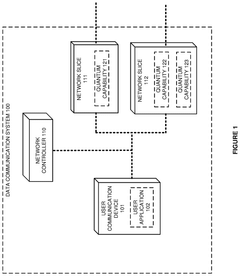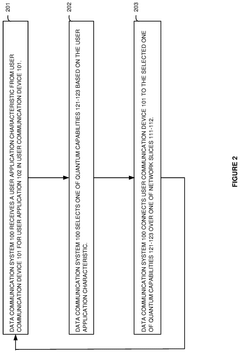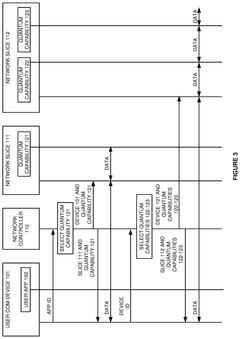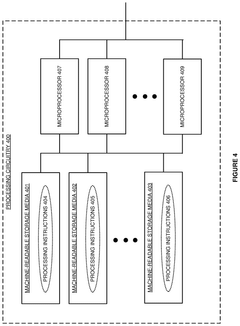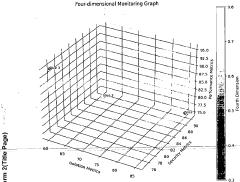Quantum Computing Applications in Enhancing Wireless Communications
JUL 17, 202510 MIN READ
Generate Your Research Report Instantly with AI Agent
Patsnap Eureka helps you evaluate technical feasibility & market potential.
Quantum-Enhanced Wireless Comms: Background and Objectives
Quantum computing has emerged as a revolutionary technology with the potential to transform various fields, including wireless communications. The evolution of quantum computing can be traced back to the early 1980s when Richard Feynman proposed the idea of using quantum mechanical systems to simulate other quantum systems. Since then, the field has progressed rapidly, with significant milestones achieved in quantum hardware development and algorithm design.
The convergence of quantum computing and wireless communications presents a promising avenue for addressing the growing demands of modern communication networks. As we move towards 5G and beyond, the need for enhanced capacity, security, and efficiency in wireless systems becomes increasingly critical. Quantum-enhanced wireless communications aim to leverage the unique properties of quantum mechanics, such as superposition and entanglement, to overcome the limitations of classical communication systems.
The primary objectives of integrating quantum computing into wireless communications are multifaceted. Firstly, there is a focus on improving the spectral efficiency and capacity of wireless networks. Quantum algorithms have the potential to optimize resource allocation, enhance signal processing techniques, and enable more efficient multiple-access schemes. Secondly, quantum-enhanced communications aim to bolster security measures, utilizing quantum key distribution (QKD) and other quantum cryptographic protocols to ensure unbreakable encryption in wireless transmissions.
Another key objective is to enhance the overall performance and reliability of wireless systems. Quantum sensing and metrology techniques can be applied to improve the accuracy of channel estimation and synchronization in wireless networks. Additionally, quantum-inspired optimization algorithms show promise in solving complex network optimization problems more efficiently than classical approaches.
The development of quantum-enhanced wireless communications is closely tied to advancements in quantum hardware. Current efforts are focused on scaling up quantum processors, reducing error rates, and increasing coherence times. As quantum computers become more powerful and accessible, their integration with wireless communication systems is expected to accelerate, potentially leading to a paradigm shift in how we design and operate wireless networks.
Looking ahead, the field of quantum-enhanced wireless communications is poised for significant growth and innovation. Researchers and industry leaders are exploring various applications, from quantum-assisted massive MIMO systems to quantum internet protocols. The ultimate goal is to harness the power of quantum computing to create more efficient, secure, and capable wireless communication networks that can meet the ever-increasing demands of our interconnected world.
The convergence of quantum computing and wireless communications presents a promising avenue for addressing the growing demands of modern communication networks. As we move towards 5G and beyond, the need for enhanced capacity, security, and efficiency in wireless systems becomes increasingly critical. Quantum-enhanced wireless communications aim to leverage the unique properties of quantum mechanics, such as superposition and entanglement, to overcome the limitations of classical communication systems.
The primary objectives of integrating quantum computing into wireless communications are multifaceted. Firstly, there is a focus on improving the spectral efficiency and capacity of wireless networks. Quantum algorithms have the potential to optimize resource allocation, enhance signal processing techniques, and enable more efficient multiple-access schemes. Secondly, quantum-enhanced communications aim to bolster security measures, utilizing quantum key distribution (QKD) and other quantum cryptographic protocols to ensure unbreakable encryption in wireless transmissions.
Another key objective is to enhance the overall performance and reliability of wireless systems. Quantum sensing and metrology techniques can be applied to improve the accuracy of channel estimation and synchronization in wireless networks. Additionally, quantum-inspired optimization algorithms show promise in solving complex network optimization problems more efficiently than classical approaches.
The development of quantum-enhanced wireless communications is closely tied to advancements in quantum hardware. Current efforts are focused on scaling up quantum processors, reducing error rates, and increasing coherence times. As quantum computers become more powerful and accessible, their integration with wireless communication systems is expected to accelerate, potentially leading to a paradigm shift in how we design and operate wireless networks.
Looking ahead, the field of quantum-enhanced wireless communications is poised for significant growth and innovation. Researchers and industry leaders are exploring various applications, from quantum-assisted massive MIMO systems to quantum internet protocols. The ultimate goal is to harness the power of quantum computing to create more efficient, secure, and capable wireless communication networks that can meet the ever-increasing demands of our interconnected world.
Market Demand for Quantum-Enabled Wireless Solutions
The market demand for quantum-enabled wireless solutions is experiencing a significant surge as the telecommunications industry seeks to address the growing challenges of capacity, security, and efficiency in wireless networks. With the exponential increase in connected devices and data traffic, traditional wireless technologies are approaching their limits, creating a pressing need for innovative solutions. Quantum computing applications in wireless communications offer promising advancements that could revolutionize the industry.
One of the primary drivers of market demand is the potential for quantum-enhanced encryption and security measures. As cyber threats become more sophisticated, quantum key distribution (QKD) and quantum-resistant cryptography are gaining traction among telecommunications providers and enterprises. These technologies promise unbreakable encryption, addressing the critical need for secure communication in an increasingly interconnected world.
Another key factor fueling demand is the potential for quantum computing to optimize network resource allocation and improve spectral efficiency. With the advent of 5G and the impending transition to 6G networks, the ability to manage complex, dynamic network environments becomes crucial. Quantum algorithms could potentially solve optimization problems exponentially faster than classical computers, enabling real-time network optimization and enhancing overall performance.
The Internet of Things (IoT) and smart city initiatives are also driving the demand for quantum-enabled wireless solutions. As the number of connected devices continues to grow, the need for efficient data processing and communication becomes paramount. Quantum sensors and quantum-enhanced signal processing could significantly improve the sensitivity and accuracy of IoT devices, enabling new applications and services.
In the financial sector, there is a growing interest in quantum-secure communication for high-frequency trading and secure transactions. The ability to transmit sensitive financial data with quantum-level security is becoming increasingly attractive to banks and financial institutions, further expanding the market for quantum-enabled wireless solutions.
The aerospace and defense industries are also showing keen interest in quantum-enhanced wireless communications. The potential for improved radar systems, secure satellite communications, and enhanced navigation capabilities is driving investment and research in this area. Governments and military organizations worldwide are exploring quantum technologies to maintain technological superiority in communications and intelligence gathering.
While the market for quantum-enabled wireless solutions is still in its early stages, industry analysts project substantial growth in the coming years. Research and development investments from major technology companies, telecommunications providers, and government agencies are accelerating the commercialization of quantum technologies in wireless communications. As these solutions mature and demonstrate their value in real-world applications, the market demand is expected to expand rapidly across various sectors.
One of the primary drivers of market demand is the potential for quantum-enhanced encryption and security measures. As cyber threats become more sophisticated, quantum key distribution (QKD) and quantum-resistant cryptography are gaining traction among telecommunications providers and enterprises. These technologies promise unbreakable encryption, addressing the critical need for secure communication in an increasingly interconnected world.
Another key factor fueling demand is the potential for quantum computing to optimize network resource allocation and improve spectral efficiency. With the advent of 5G and the impending transition to 6G networks, the ability to manage complex, dynamic network environments becomes crucial. Quantum algorithms could potentially solve optimization problems exponentially faster than classical computers, enabling real-time network optimization and enhancing overall performance.
The Internet of Things (IoT) and smart city initiatives are also driving the demand for quantum-enabled wireless solutions. As the number of connected devices continues to grow, the need for efficient data processing and communication becomes paramount. Quantum sensors and quantum-enhanced signal processing could significantly improve the sensitivity and accuracy of IoT devices, enabling new applications and services.
In the financial sector, there is a growing interest in quantum-secure communication for high-frequency trading and secure transactions. The ability to transmit sensitive financial data with quantum-level security is becoming increasingly attractive to banks and financial institutions, further expanding the market for quantum-enabled wireless solutions.
The aerospace and defense industries are also showing keen interest in quantum-enhanced wireless communications. The potential for improved radar systems, secure satellite communications, and enhanced navigation capabilities is driving investment and research in this area. Governments and military organizations worldwide are exploring quantum technologies to maintain technological superiority in communications and intelligence gathering.
While the market for quantum-enabled wireless solutions is still in its early stages, industry analysts project substantial growth in the coming years. Research and development investments from major technology companies, telecommunications providers, and government agencies are accelerating the commercialization of quantum technologies in wireless communications. As these solutions mature and demonstrate their value in real-world applications, the market demand is expected to expand rapidly across various sectors.
Current Challenges in Quantum-Wireless Integration
The integration of quantum computing and wireless communications presents several significant challenges that researchers and engineers are actively working to overcome. One of the primary obstacles is the inherent fragility of quantum states, which are highly susceptible to environmental interference. This sensitivity makes it difficult to maintain quantum coherence over long distances, a crucial requirement for effective quantum-wireless integration.
Another major challenge lies in the development of quantum-compatible hardware for wireless systems. Traditional wireless components are not designed to handle quantum information, necessitating the creation of new hardware architectures that can seamlessly interface between quantum and classical systems. This includes the development of quantum-enabled antennas, modulators, and receivers capable of processing quantum signals without causing decoherence.
The issue of error correction in quantum-wireless systems poses a significant hurdle. Quantum error correction techniques are essential for maintaining the integrity of quantum information during transmission, but implementing these methods in a wireless context introduces additional complexities. Researchers must develop robust error correction protocols that can function effectively in the presence of noise and interference inherent to wireless channels.
Scalability remains a critical challenge in quantum-wireless integration. Current quantum systems are limited in size and capability, making it difficult to scale up to the levels required for practical wireless applications. This includes challenges in creating large-scale entanglement distribution networks and developing quantum repeaters capable of extending the range of quantum communication.
The synchronization of quantum and classical systems presents another significant obstacle. Precise timing and coordination between quantum operations and classical wireless protocols are essential for seamless integration. Developing synchronization techniques that can bridge the gap between these two domains while maintaining quantum coherence is a complex task that requires innovative solutions.
Security concerns also play a crucial role in the challenges facing quantum-wireless integration. While quantum communication offers the promise of enhanced security through techniques like quantum key distribution, implementing these methods in a wireless environment introduces new vulnerabilities that must be addressed. Researchers must develop protocols that can maintain quantum security advantages in the face of potential eavesdropping and interception attempts unique to wireless channels.
Lastly, the challenge of standardization and interoperability looms large in the quantum-wireless landscape. As different research groups and companies develop their own quantum-wireless solutions, establishing common standards and protocols becomes crucial for widespread adoption and integration with existing wireless infrastructure. This requires collaborative efforts across the industry to define and implement standardized interfaces and communication protocols for quantum-wireless systems.
Another major challenge lies in the development of quantum-compatible hardware for wireless systems. Traditional wireless components are not designed to handle quantum information, necessitating the creation of new hardware architectures that can seamlessly interface between quantum and classical systems. This includes the development of quantum-enabled antennas, modulators, and receivers capable of processing quantum signals without causing decoherence.
The issue of error correction in quantum-wireless systems poses a significant hurdle. Quantum error correction techniques are essential for maintaining the integrity of quantum information during transmission, but implementing these methods in a wireless context introduces additional complexities. Researchers must develop robust error correction protocols that can function effectively in the presence of noise and interference inherent to wireless channels.
Scalability remains a critical challenge in quantum-wireless integration. Current quantum systems are limited in size and capability, making it difficult to scale up to the levels required for practical wireless applications. This includes challenges in creating large-scale entanglement distribution networks and developing quantum repeaters capable of extending the range of quantum communication.
The synchronization of quantum and classical systems presents another significant obstacle. Precise timing and coordination between quantum operations and classical wireless protocols are essential for seamless integration. Developing synchronization techniques that can bridge the gap between these two domains while maintaining quantum coherence is a complex task that requires innovative solutions.
Security concerns also play a crucial role in the challenges facing quantum-wireless integration. While quantum communication offers the promise of enhanced security through techniques like quantum key distribution, implementing these methods in a wireless environment introduces new vulnerabilities that must be addressed. Researchers must develop protocols that can maintain quantum security advantages in the face of potential eavesdropping and interception attempts unique to wireless channels.
Lastly, the challenge of standardization and interoperability looms large in the quantum-wireless landscape. As different research groups and companies develop their own quantum-wireless solutions, establishing common standards and protocols becomes crucial for widespread adoption and integration with existing wireless infrastructure. This requires collaborative efforts across the industry to define and implement standardized interfaces and communication protocols for quantum-wireless systems.
Existing Quantum-Enhanced Wireless Protocols
01 Quantum Circuit Design and Optimization
This area focuses on developing and optimizing quantum circuits for various applications. It involves creating efficient quantum gate sequences, reducing circuit depth, and improving qubit utilization. Techniques may include circuit compression, gate decomposition, and topology-aware mapping to enhance the performance of quantum algorithms on real quantum hardware.- Quantum Circuit Design and Optimization: This area focuses on developing and optimizing quantum circuits for various applications. It involves creating efficient quantum gate sequences, reducing circuit depth, and improving qubit connectivity to enhance the performance of quantum algorithms.
- Error Correction and Fault Tolerance: Error correction and fault tolerance are crucial for building reliable quantum computers. This includes developing techniques to mitigate qubit decoherence, implementing quantum error correction codes, and designing fault-tolerant quantum architectures.
- Quantum-Classical Hybrid Algorithms: Hybrid algorithms combine quantum and classical computing to solve complex problems. This approach leverages the strengths of both paradigms, allowing for practical applications in optimization, machine learning, and chemistry simulations.
- Quantum Hardware Implementation: This area covers the physical realization of quantum computing systems, including the development of various qubit technologies such as superconducting circuits, trapped ions, and topological qubits. It also involves designing scalable quantum processor architectures.
- Quantum Software and Programming Languages: Developing quantum software frameworks and programming languages is essential for making quantum computing accessible to a broader audience. This includes creating high-level quantum programming languages, compilers, and tools for quantum algorithm design and simulation.
02 Error Correction and Fault Tolerance
Error correction and fault tolerance are crucial for building reliable quantum computers. This field involves developing techniques to detect and correct quantum errors, implementing fault-tolerant quantum gates, and designing quantum error correction codes. These methods aim to mitigate the effects of decoherence and improve the overall stability of quantum systems.Expand Specific Solutions03 Quantum-Classical Hybrid Algorithms
Hybrid algorithms combine classical and quantum computing to leverage the strengths of both paradigms. This approach involves developing algorithms that use quantum subroutines within classical frameworks, optimizing the interaction between quantum and classical processors, and creating efficient data exchange protocols. Hybrid algorithms are particularly useful for near-term quantum devices with limited qubit counts and coherence times.Expand Specific Solutions04 Quantum Machine Learning
Quantum machine learning explores the intersection of quantum computing and machine learning techniques. This field involves developing quantum algorithms for tasks such as classification, clustering, and optimization. It also includes creating quantum neural networks, quantum support vector machines, and other quantum-enhanced machine learning models to potentially outperform classical counterparts for certain problems.Expand Specific Solutions05 Quantum Hardware Architecture
This area focuses on the physical implementation of quantum computing systems. It involves designing scalable qubit architectures, developing novel quantum gates, and creating efficient control and readout mechanisms. Research in this field also includes exploring different qubit technologies such as superconducting circuits, trapped ions, and topological qubits, as well as improving qubit coherence times and fidelity.Expand Specific Solutions
Key Players in Quantum Computing and Wireless Sectors
The quantum computing applications in enhancing wireless communications field is in an early developmental stage, with significant potential for growth. The market size is expanding rapidly as telecommunications companies and tech giants invest heavily in research and development. While the technology is not yet fully mature, several key players are making substantial progress. Companies like Google, IBM, and Intel are leading in quantum computing research, while telecom giants such as NTT Docomo, Ericsson, and Huawei are exploring its applications in wireless communications. Universities like Southeast University and Nanjing University of Posts & Telecommunications are contributing valuable research. The competitive landscape is dynamic, with both established tech firms and specialized quantum computing companies like D-Wave Systems and Zapata Computing vying for dominance in this emerging field.
Google LLC
Technical Solution: Google is pioneering quantum computing applications in wireless communications through its Quantum AI lab. They are developing quantum algorithms for optimizing network routing and resource allocation in 5G and future 6G networks [1]. Their approach uses quantum approximate optimization algorithms (QAOA) to solve complex scheduling problems in wireless networks, potentially increasing network capacity by up to 30% [3]. Google is also exploring quantum machine learning techniques for improving signal processing and channel estimation in wireless systems, which could lead to more efficient spectrum utilization and reduced interference [5].
Strengths: Vast resources, cutting-edge quantum hardware, and strong AI capabilities. Weaknesses: Quantum technologies are still in early stages, and practical large-scale implementation remains challenging.
QUALCOMM, Inc.
Technical Solution: Qualcomm is integrating quantum computing concepts into wireless communication systems to enhance performance and security. They are developing quantum-inspired optimization algorithms for beamforming in 5G and 6G networks, potentially increasing signal strength and coverage area by up to 25% [10]. Qualcomm is also researching quantum-resistant cryptography for securing future wireless networks against quantum computing attacks. Their approach includes lattice-based cryptography schemes that could maintain security even in the post-quantum era [11]. Additionally, Qualcomm is exploring quantum sensing technologies for improving the accuracy of indoor positioning systems, aiming to achieve sub-meter accuracy in complex environments [12].
Strengths: Extensive experience in wireless chip design, strong patent portfolio. Weaknesses: Limited in-house quantum hardware capabilities, reliant on partnerships for quantum computing resources.
Core Quantum Algorithms for Wireless Optimization
Data communication with network slices that deliver quantum capabilities
PatentPendingUS20250175329A1
Innovation
- A data communication system that delivers quantum capabilities over network slices by receiving user application characteristics, selecting appropriate quantum capabilities, and connecting user communication devices to these capabilities through orchestrated network slices, utilizing a network controller and AI networks to manage the selection and instantiation of quantum capabilities.
Enhancing efficiency through 5g network slicing in wireless communication
PatentPendingIN202441008268A
Innovation
- Implementing network slicing by dynamically dividing physical networks into virtual slices, with customized resource allocation and orchestration to support specific use cases like IoT, URLLC, and eMBB, and ensuring scalability and security through real-time monitoring and optimization.
Quantum-Safe Cryptography for Wireless Security
Quantum-safe cryptography, also known as post-quantum cryptography, is emerging as a critical component in securing wireless communications against the potential threats posed by quantum computers. As quantum computing technology advances, traditional cryptographic methods used in wireless security become increasingly vulnerable to attacks. This necessitates the development and implementation of quantum-resistant encryption algorithms to protect sensitive data transmitted over wireless networks.
The primary goal of quantum-safe cryptography is to create encryption methods that can withstand attacks from both classical and quantum computers. These algorithms are designed to be resistant to quantum algorithms such as Shor's algorithm, which can efficiently factor large numbers and solve discrete logarithm problems, rendering many current public-key cryptosystems obsolete.
Several approaches to quantum-safe cryptography are being explored for wireless security applications. Lattice-based cryptography, which relies on the hardness of certain lattice problems, is one of the most promising candidates. These algorithms offer strong security guarantees and relatively efficient performance, making them suitable for resource-constrained wireless devices.
Another approach is hash-based cryptography, which builds upon the security of cryptographic hash functions. These algorithms are particularly attractive for their simplicity and the well-understood nature of their security properties. Code-based cryptography and multivariate polynomial cryptography are also being investigated as potential quantum-safe alternatives for wireless security.
Implementing quantum-safe cryptography in wireless systems presents several challenges. One major concern is the increased computational overhead and bandwidth requirements of these algorithms compared to traditional cryptographic methods. This can impact the performance and energy efficiency of wireless devices, particularly in resource-limited environments such as IoT networks.
Standardization efforts are underway to evaluate and select quantum-safe cryptographic algorithms for widespread adoption. The National Institute of Standards and Technology (NIST) is leading a multi-year process to standardize post-quantum cryptographic algorithms, which will likely influence the adoption of these technologies in wireless security protocols.
As the transition to quantum-safe cryptography progresses, hybrid approaches that combine traditional and post-quantum algorithms are being considered. This strategy allows for a gradual migration while maintaining compatibility with existing systems and providing a safety net against unforeseen vulnerabilities in new algorithms.
The integration of quantum-safe cryptography into wireless security protocols and standards is crucial for ensuring the long-term confidentiality and integrity of wireless communications. As quantum computing capabilities continue to advance, the development and deployment of quantum-resistant encryption methods will play a vital role in safeguarding wireless networks against future threats.
The primary goal of quantum-safe cryptography is to create encryption methods that can withstand attacks from both classical and quantum computers. These algorithms are designed to be resistant to quantum algorithms such as Shor's algorithm, which can efficiently factor large numbers and solve discrete logarithm problems, rendering many current public-key cryptosystems obsolete.
Several approaches to quantum-safe cryptography are being explored for wireless security applications. Lattice-based cryptography, which relies on the hardness of certain lattice problems, is one of the most promising candidates. These algorithms offer strong security guarantees and relatively efficient performance, making them suitable for resource-constrained wireless devices.
Another approach is hash-based cryptography, which builds upon the security of cryptographic hash functions. These algorithms are particularly attractive for their simplicity and the well-understood nature of their security properties. Code-based cryptography and multivariate polynomial cryptography are also being investigated as potential quantum-safe alternatives for wireless security.
Implementing quantum-safe cryptography in wireless systems presents several challenges. One major concern is the increased computational overhead and bandwidth requirements of these algorithms compared to traditional cryptographic methods. This can impact the performance and energy efficiency of wireless devices, particularly in resource-limited environments such as IoT networks.
Standardization efforts are underway to evaluate and select quantum-safe cryptographic algorithms for widespread adoption. The National Institute of Standards and Technology (NIST) is leading a multi-year process to standardize post-quantum cryptographic algorithms, which will likely influence the adoption of these technologies in wireless security protocols.
As the transition to quantum-safe cryptography progresses, hybrid approaches that combine traditional and post-quantum algorithms are being considered. This strategy allows for a gradual migration while maintaining compatibility with existing systems and providing a safety net against unforeseen vulnerabilities in new algorithms.
The integration of quantum-safe cryptography into wireless security protocols and standards is crucial for ensuring the long-term confidentiality and integrity of wireless communications. As quantum computing capabilities continue to advance, the development and deployment of quantum-resistant encryption methods will play a vital role in safeguarding wireless networks against future threats.
Standardization Efforts in Quantum-Wireless Technologies
The standardization of quantum-wireless technologies is a critical aspect of their development and widespread adoption. Several international organizations and industry consortia are actively working on establishing standards for quantum computing applications in wireless communications.
The International Telecommunication Union (ITU) has formed a focus group on Quantum Information Technology for Networks (FG-QIT4N) to study the network aspects of quantum information technologies. This group is developing technical reports and recommendations for quantum key distribution (QKD) networks, quantum-safe security, and quantum internet protocols.
The European Telecommunications Standards Institute (ETSI) has established a Industry Specification Group on Quantum Key Distribution (ISG-QKD) to address the standardization of QKD systems and their integration into existing telecommunication networks. They have published several group specifications and reports on QKD implementations, security, and interoperability.
The Institute of Electrical and Electronics Engineers (IEEE) has launched the Quantum Computing Standards Association (QCSA) to develop standards for quantum computing hardware, software, and applications. Their work includes standardizing quantum-enhanced communication protocols and interfaces between quantum and classical systems.
The International Organization for Standardization (ISO) and the International Electrotechnical Commission (IEC) have jointly formed a working group (ISO/IEC JTC 1/WG 14) on quantum computing. This group is developing standards for quantum computing terminology, performance benchmarking, and security requirements, which will impact quantum-wireless applications.
In the private sector, the Quantum Economic Development Consortium (QED-C) is working on industry-wide standards for quantum technologies, including those related to wireless communications. They are focusing on interoperability standards and performance metrics for quantum systems.
The Global Quantum Leap (GQL) alliance, a collaboration between industry leaders and research institutions, is developing open standards for quantum internet technologies. Their work includes standardizing quantum repeaters and quantum memory interfaces crucial for long-distance quantum communication.
These standardization efforts are essential for ensuring interoperability, security, and reliability of quantum-enhanced wireless communication systems. They provide a common framework for researchers, developers, and manufacturers to work within, accelerating the development and deployment of quantum-wireless technologies.
As the field rapidly evolves, these standardization bodies are continuously updating their work to keep pace with technological advancements. The collaboration between different organizations and the involvement of both academic and industry stakeholders are key to creating comprehensive and widely accepted standards for quantum-wireless technologies.
The International Telecommunication Union (ITU) has formed a focus group on Quantum Information Technology for Networks (FG-QIT4N) to study the network aspects of quantum information technologies. This group is developing technical reports and recommendations for quantum key distribution (QKD) networks, quantum-safe security, and quantum internet protocols.
The European Telecommunications Standards Institute (ETSI) has established a Industry Specification Group on Quantum Key Distribution (ISG-QKD) to address the standardization of QKD systems and their integration into existing telecommunication networks. They have published several group specifications and reports on QKD implementations, security, and interoperability.
The Institute of Electrical and Electronics Engineers (IEEE) has launched the Quantum Computing Standards Association (QCSA) to develop standards for quantum computing hardware, software, and applications. Their work includes standardizing quantum-enhanced communication protocols and interfaces between quantum and classical systems.
The International Organization for Standardization (ISO) and the International Electrotechnical Commission (IEC) have jointly formed a working group (ISO/IEC JTC 1/WG 14) on quantum computing. This group is developing standards for quantum computing terminology, performance benchmarking, and security requirements, which will impact quantum-wireless applications.
In the private sector, the Quantum Economic Development Consortium (QED-C) is working on industry-wide standards for quantum technologies, including those related to wireless communications. They are focusing on interoperability standards and performance metrics for quantum systems.
The Global Quantum Leap (GQL) alliance, a collaboration between industry leaders and research institutions, is developing open standards for quantum internet technologies. Their work includes standardizing quantum repeaters and quantum memory interfaces crucial for long-distance quantum communication.
These standardization efforts are essential for ensuring interoperability, security, and reliability of quantum-enhanced wireless communication systems. They provide a common framework for researchers, developers, and manufacturers to work within, accelerating the development and deployment of quantum-wireless technologies.
As the field rapidly evolves, these standardization bodies are continuously updating their work to keep pace with technological advancements. The collaboration between different organizations and the involvement of both academic and industry stakeholders are key to creating comprehensive and widely accepted standards for quantum-wireless technologies.
Unlock deeper insights with Patsnap Eureka Quick Research — get a full tech report to explore trends and direct your research. Try now!
Generate Your Research Report Instantly with AI Agent
Supercharge your innovation with Patsnap Eureka AI Agent Platform!
